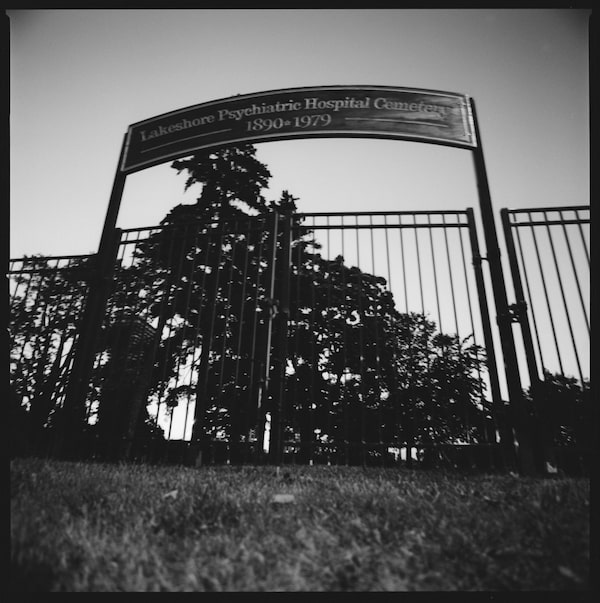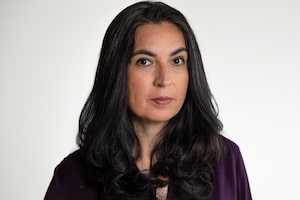
Flowers and a small square of concrete mark an un-named gravesite at the Lakeshore Psychiatric Hospital Cemetery, on June 21. Tanya Talaga’s great great grandmother is buried in the small cemetery located between the Gardiner Expressway and Evans Ave.Fred Lum/The Globe and Mail
Just off the side of one of Canada’s busiest highways, between the popular Sherway Gardens shopping mall and a hulking IKEA store, lie the remains of 1,511 people.
This patch of land off Ontario’s Gardiner Expressway was once the Lakeshore Cemetery, which was primarily the burial place for those who died in a nearby hospital between 1890 to 1974. That institution, which closed in 1979, had many names during its existence – the Mimico Insane Asylum, the Mimico Hospital for the Insane, the Ontario Hospital, the Lakeshore Psychiatric Hospital – but for too many, it was a place of nightmares, rife with communicable diseases such as tuberculosis, and with staff who engaged in electric-shock therapy, insulin-shock therapy and lobotomies.
It is believed that dozens of Indigenous peoples are buried under the cemetery’s sloped, uneven grass, in unmarked plots, 3 feet by 8 feet long. They lie here alone, far from their homes, their languages, their ways of life. When they died, they were dismissed as indigents; many were placed in plots without markers.
I know this, because I now know that my great-great-grandmother, Annie Gauthier, rests here.
For nine decades, Annie has been one of the disappeared – a First Nations woman never to be seen again. Gone with her was all her knowledge, her stories, of who she was, where she was from, who she loved and why we lost her.
All we had to go on were the few and precious papers passed down to me by my uncle, Hank Bowen, after he died. Her death certificate told us that Mrs. Ann Gauthier, wife of French-Canadian trapper Joseph Gauthier, passed away while she was a “patient” at the Ontario Hospital. We did not know how she got there, who put her there and why. All we had left were pieces of an Indigenous woman whose maiden name was Carpenter, and whose blood and body is of this land.
For so many First Nations families, this is all we have left to go on: fragments passed down to us in our stories, through our whispers and, sometimes, through written records that often contain half-truths and vague clues.
You see, these “records” were written by Indian Agents, medical professionals, church officials, the Hudson’s Bay Company and those who worked in the institutions that took our people – not by us. More often than not, the record takers did not bother to write down the correct spelling of a name, or accurately log a person’s age, birthplace or parentage.
So even though Annie Gauthier was Cree from the James Bay coast, her death certificate lists her as “French-Indian.” As an Indigenous woman in the 1930s, this is what her identity became – that of her French-Canadian husband’s. The document also missed other important details, such as her date of birth, her correct age, and who her mother and father were.
If even these fundamental details were wrong or missing, how could we trust anything?
Annie spent seven years, eight months and 28 days in the hospital, we were told, and died on March 20, 1937, of “broncho-pneumonia,” with contributing factors of “acute peritonitis, gangrene of the intestine.” Were proper investigations even carried out?
But at the bottom left of the certificate, her burial place is listed, vaguely: “Institution Cemetery, New Toronto.” Directly underneath, the undertaker is listed as from “Mimico.” That’s all we had to work with.
For the past two years, I have been thinking about Annie as I worked on my book, The Knowing, about how the genocidal policies that shaped Canada nearly ruined parts of my family. Through a friend, I was introduced to Ryan Shackleton, the owner of Know History, an Ottawa-based research company. I told him about my family’s hunt for Annie, and his firm told me about a man named Ed Janiszewski, and the amazing work he had done to restore a lost cemetery in a Toronto neighbourhood called Mimico.
It was an incredible lead. I sent Ed an e-mail last September, and told him about Annie.
“Pleased to make your acquaintance,” he replied. “I am glad that I have been able to have you connect with your Great-Great Grandmother, Ann Gauthier’s resting place.”

The Mimico branch of the Toronto Lunatic Asylum opened on Jan. 21, 1890. Sending people who died at the facility home would have cost too much, so they were buried in a nearby field.Fred Lum/The Globe and Mail
The Mimico branch of the Toronto Lunatic Asylum opened on Jan. 21, 1890. The 1891 annual report for the Toronto Asylum – which then comprised just two institutions, the one in Mimico and another in downtown Toronto – makes for riveting reading. In that first year ending September, 1890, 73 patients died. Among the causes of death listed: “killed,” “suicide,” “exhaustion from mania,” “senile decay,” “cardiac disease” and “dysentery,” to name a few.
It also lists the reasons that patients were admitted, revealing what was viewed as a “mental illness” at the time; they range from “domestic troubles, including loss of relatives or friends, religious excitement, adverse circumstances including business troubles, love affairs – including seduction, mental anxiety ‘worry’, frights and nervous shocks.”
In short, these were not just asylums as we might understand them today. Before the advent of the “welfare state,” these places were scattered across Canada, providing a service for the elderly, the infirm, those facing difficulty and those without any means to support themselves.
They were also places where fundamental human rights could be forgotten.
A report released in June by Kimberly Murray – appointed last year by the federal government to develop a framework for the respectful treatment of unmarked grave sites – revealed more about the Mimico asylum. She found that patients did forced labour and experienced violent restraint methods – which, unfortunately, “was not unusual for psychiatric hospitals during this time.” Many of them – an unknown number of them Indigenous – died of tuberculosis.
Sending the dead home would have cost too much, so they were buried in a nearby field, some distance from the growing city of Toronto; according to the report, fellow patients even helped to dig the graves and construct the coffins. Families of the deceased were not contacted, not told how their loved ones died. Personal belongings were never returned.
This is a pattern seen among so many of our families seeking traces of loved ones and ancestors who have disappeared from Indian Hospitals, asylums, tuberculosis sanatoriums and residential schools. “Indigenous people, including children, were taken and transferred to, and between, many different institutions, including institutions like the Lakeshore Asylum,” Ms. Murray told me in an interview, using one of the hospital’s most recent names. “The systems and patterns of colonial violence that existed in the Indian Residential School system extended to these associated institutions.”
It’s all the same story. For many family members, the ending was the same, too: Without meaningful information from institutions, it was as if their loved ones had simply vanished.

The provincial government – which owns the Lakeshore cemetery – effectively abandoned the site after the Mimico asylum closed down in 1979.Fred Lum/The Globe and Mail
After the Mimico asylum closed down in 1979, the provincial government – which owns the Lakeshore cemetery – effectively abandoned the site. But in 2002, Ed Janiszewski – who had worked for the Lakeshore psychiatric hospital before it shut down and partly merged into what is now the Centre for Addiction and Mental Health – found burial records for the asylum in CAMH’s archives, for a cemetery he’d hadn’t heard of. When he went to the listed address, he found an overgrown, unkempt and forgotten plot of land.
He decided to do something about it. He wrote letters, formed a working committee and, contacting politicians, and his advocacy, along with volunteers such as York University professor Geoffrey Reaume, led the Ontario government to finally memorialize the cemetery in 2012 with a fence and a commemorative plaque.
Since then, he has been working to restore the gravesites and identify the unmarked ones. Over the years, he’s accumulated binders full of information about the cemetery, including a list of 1,511 names of those believed to be buried on the grounds.
Annie’s name was among them. He had a plot number for her, he told me – but her grave was unmarked.
So last fall, my mother, daughter and I visited the cemetery, joined by Ed and his team of volunteers. Twice a year, they clean up the site and tend to the grave markers every spring and fall; about 150 are marked, so far. My mother had lived her life knowing nothing about her great-grandmother, other than the mission to find her; earlier that year, she had lost her mother Margaret – Annie’s granddaughter. It was incredibly emotional to arrive at the site.
Words cannot describe what it was like to be there, after all this time, to know that Annie was right here, so close to us. We smudged, we cried, we laid down flowers and we touched the earth, knowing we were reclaiming her – that we had come to take her spirit home.

Flowers mark gravesites at the cemetery.Fred Lum/The Globe and Mail
Since then, a working group has been set up connecting the Anishinabek Nation, Nishnawbe Aski Nation, the Ontario Chief Coroner’s Office, and Kimberly Murray’s office to go through the names Mr. Janiszewski has collected. He had already identified more than a dozen of them as First Nations, but Ms. Murray has been able to identify more, finding their death records and confirming they were Indigenous – including one youth listed only as “Indian Boy,” from Algoma, Ont., who died in 1913 at age 22.
As Ms. Murray points out in her report, Indigenous burials are consistently given less respect and protection than government-run, church-run or private ceremonies, and the burial sites themselves are typically treated with less respect if the deceased is Indigenous, often unworthy even of a headstone, allowing the people to slip anonymously away into history.
These echoes of the past are still with us today. Our children, our women and our Peoples are still being lost to us, by causes recorded as “sudden deaths” with “no further investigations” necessary.
And still, we have to fight many of these same institutions for assistance – for access to records in their hidden boxes containing briefings of yesteryear – just to help us bring our family members home.
We found our vanished Annie, after generations of looking. No family should be forced to wait so long.

Fred Lum/The Globe and Mail
 Tanya Talaga
Tanya Talaga